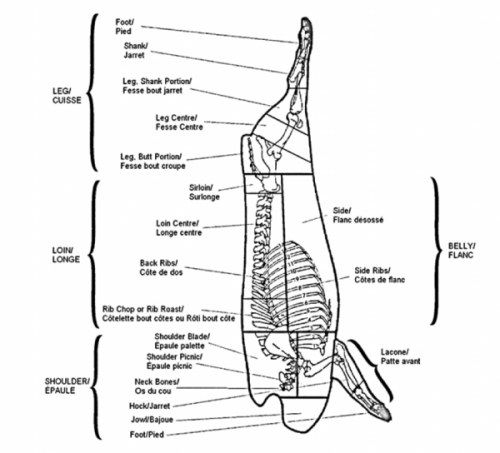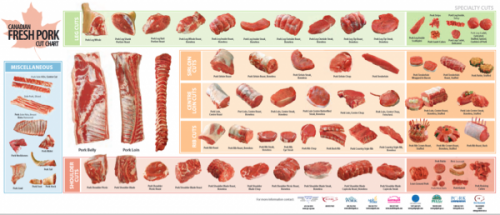Cutting and Processing Meats
Pork
Pork is a very popular and versatile meat. Due to its size, it can be merchandised and delivered as whole, in sides, or broken down into primals (Figure 23). The majority of the pork comes from choice butcher hogs that are about six months old at the age of slaughter. The entire dressed hog carcass weighs about 75 kilograms (165 pounds). Very little of the hog carcass goes to waste. It can be retailed fresh, cured, or smoked and can be very profitable if merchandised in a number of ways. Intestines are processed for sausage casings, and fat is harvested to be used in sausage manufacturing as well as barding and larding of lean meats. Head, feet, and skin are used for their rich amounts of natural gelatin. Occasionally feet and hocks are sold as sweet pickle.

The side of pork is broken down into sub-primals from the four primals: pork shoulder, pork leg, pork loin, and pork belly as shown in Figure 24 and Table 30.

| Primal | Sub-Primal |
| Pork leg | Pork leg butt portion (D) |
| Pork leg shank portion (C) | |
| Pork hock (B) | |
| Pork foot (A) | |
| Pork loin | Pork loin rib end (G) |
| Pork loin centre (F) | |
| Pork sirloin (E) | |
| Pork belly | No further breakdown (H) |
| Pork shoulder | Pork shoulder blade (I) |
| Pork shoulder picnic (J) | |
| Pork jowl (K) | |
| Pork foot (M) | |
| Pork hock (L) |
Pork Leg
The pork leg is a very lean portion of the hog. It can be separated into three muscle groups: the inside, outside, and tip. It also contains a hock and a foot. The leg is tender and mostly free from connective tissue, making it ideal for dry heat cookery. Fresh roasts and steaks are processed from the leg as well as cutlets. Most commonly, the pork leg is cured and smoked to produce ham. It can also be dry cured and aged to produce prosciutto. Retail and smoked cuts from the leg are shown in Table 31.
| Primal | Retail Meat Sales Cuts | Retail Cured and smoked Cuts | Alternate Names |
| Pork Leg | Pork leg inside roast | Pork leg ham whole (b)(bl) | Fresh ham |
| Pork leg outside roast | Pork leg ham piece boneless | ||
| Pork leg tip roast | |||
| Pork leg steak (b)(bl) | Pork leg ham steak (b)(bl) | ||
| Pork leg cutlet | Schnitzel | ||
| Pork leg shank portion | Pork leg ham (shank portion) | ||
| Pork leg centre portion | |||
| Pork leg butt portion | |||
| Pork hock | Pork leg ham (butt portion) | Shank | |
| Pork foot | Pork hock (smoked) | Trotter |
Pork Loin
The pork loin is commonly split into three sections: the rib, sirloin, and loin centre. Alternatively, the pork loin can be split at the end of the tenderloin, labelling the two halves as pork loin rib half and pork loin sirloin half. The pork loin is most often merchandised fresh for chops and roasts. The loin in the most tender primal of the hog and is ideal for dry heat cookery. It can be cured and smoked to make favourites such as back bacon. Retail and smoked cuts from the loin are shown in Table 32.
| Primal | Retail Meat Sales Cuts | Retail Cured and smoked Cuts | Alternate names |
| Pork loin | Pork loin centre chops (b)(bl) | Pork loin centre chop (smoked) | Kassler loin |
| Pork loin centre roast (b)(bl) | Pork loin centre back bacon (smoked) | Canadian bacon | |
| Pork back ribs | |||
| Pork sirloin chop (b)(bl) | Pork sirloin chop smoked | Baby back ribs | |
| Pork sirloin roast (b)(bl) | |||
| Pork rib chop (b)(bl) | Pork rib chop smoked | ||
| Pork loin rib country-style chop |
Pork Shoulder
The pork shoulder is very popular for use in sausage making due to the higher fat content. The sub-primals pork shoulder blade and pork shoulder picnic are derived from the shoulder along with a pork hock and a pork foot. It can be merchandised as fresh roasts and steaks, cured and smoked products, and for deli meats such as capicollo. Retail and smoked cuts from the shoulder are shown in Table 33.
| Sub-primal | Retail Meat Sales Cuts | Retail Cured and Smoked Cuts | Alternate Names |
| Pork shoulder blade | Pork shoulder blade Steaks (b)(bl) | ||
| Pork shoulder blade roast (b)(bl) | Pork cottage roll (smoked) | Pork butt Boston butt | |
| Pork shoulder picnic | Pork shoulder picnic blade portion | Pork shoulder picnic (smoked) | The blade and picnic together are sometimes referred to as the Montreal shoulder |
| Pork shoulder picnic shank portion | |||
| Pork riblets | |||
| Pork jowl | Pork jowl (smoked) | Jowl bacon | |
| Pork foot | Pickled pigs’ feet | ||
| Pork hock | Smoked hocks |
Pork Belly
The pork belly contains the most amount of fat on the hog. It contains the pork side ribs and pork breastbone. When the side ribs are removed, the retail name for the belly is side pork. This is the section cured and smoked to make pork side bacon. The side pork can also be rolled and processed to make pancetta. Retail and smoked cuts from the belly are shown in Table 34.
| Primal | Retail Meat Sales Cuts | Retail Cured and Smoked Cuts | Alternate names |
| Pork belly | Side pork fresh | Pork side bacon | Pork belly |
| Pork side ribs | Spareribs | ||
| Pork side ribs center cut | St. Louis ribs |
Figure 25 shows the different pork cuts. For a complete Canadian pork cuts chart, visit Manitoba Pork.

Media Attributions
- Pork carcass © CFIA. Used with permission of the CFIA
- Pork primal and sub-primal cuts. © Jakes and Associates is licensed under a CC BY-NC (Attribution NonCommercial) license
- Pork cut chart © Manitoba Pork
Preserved or flavoured by applying smoke to meats, usually after curing. Cold smoking is done at lower temperatures so as not to cook the protein in the meat; hot smoking is done at higher temperatures to cook the protein and smoke it at the same time.
A technique for cooking meats where the meat is wrapped in a layer of fat before cooking it.
The process of inserting strips of fat into lean meats using a larding needle to prevent meat from drying out.
A term used to describe a meat product that has been brined but not smoked.
A relatively thin, boneless cut of meat.
A cut of meat including part of the rib.

